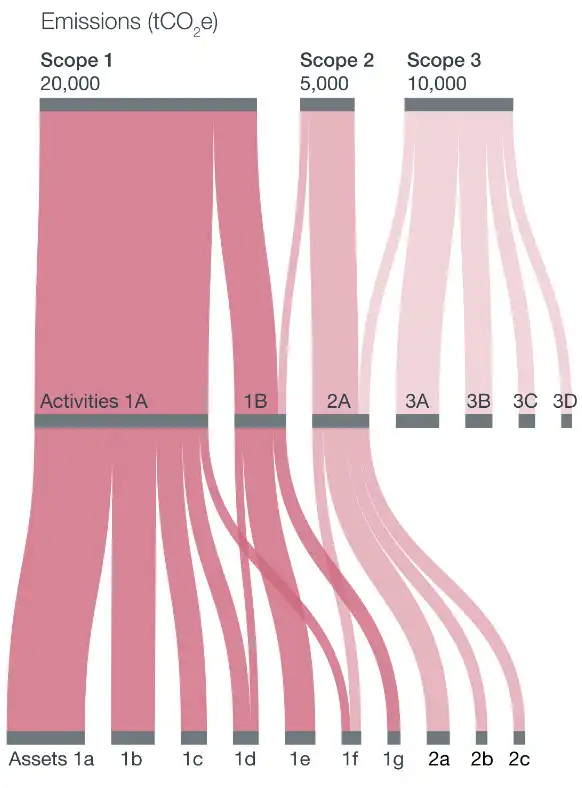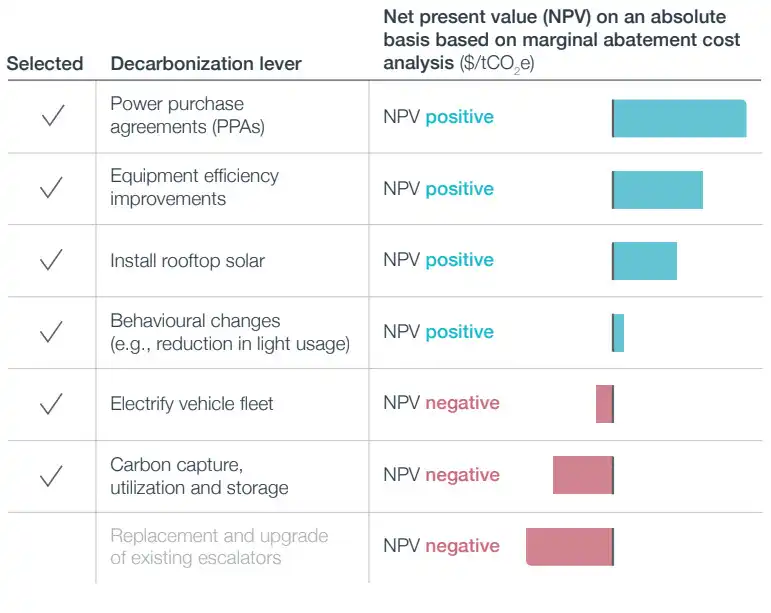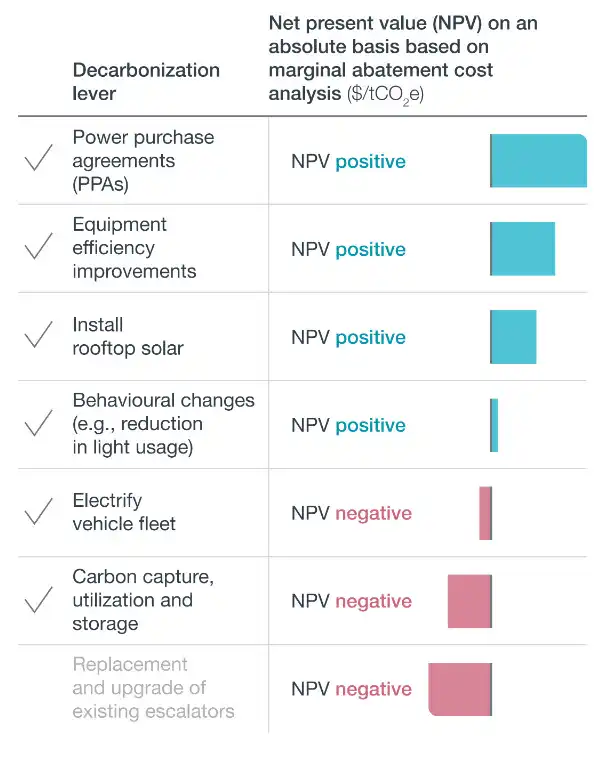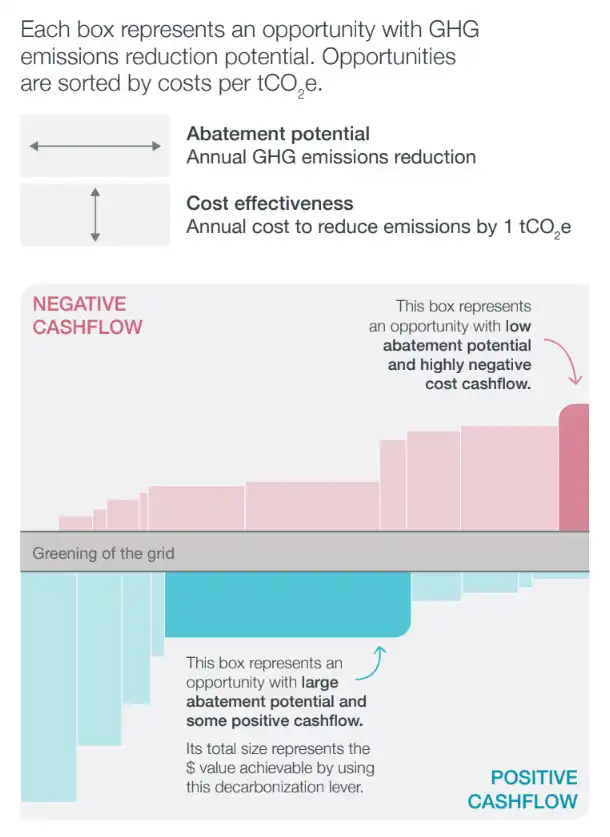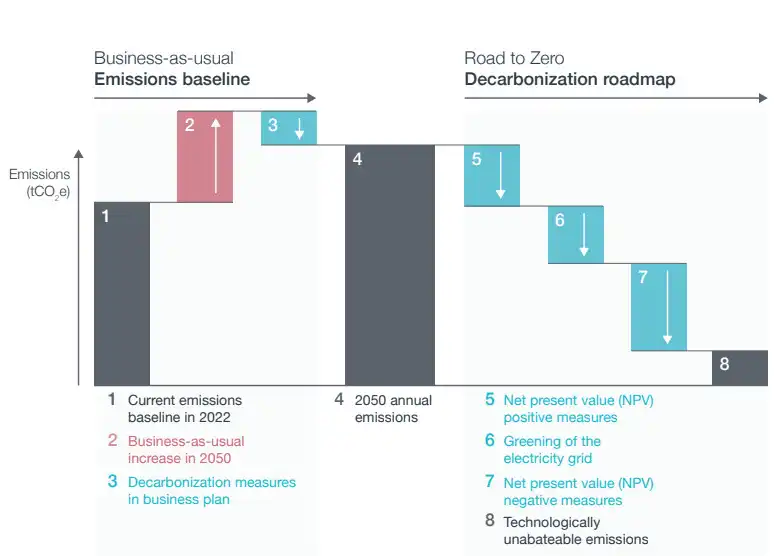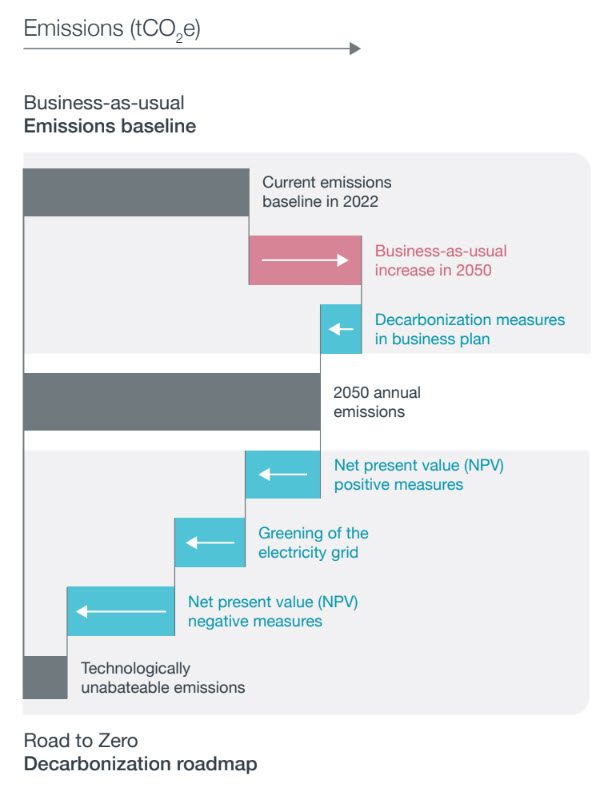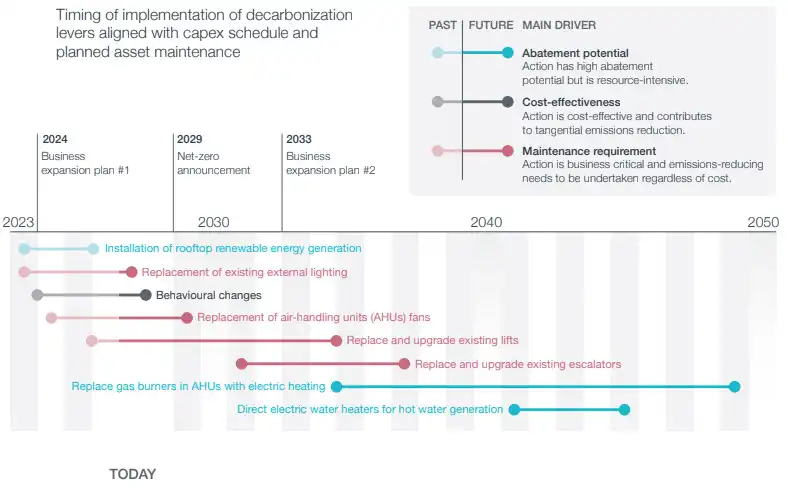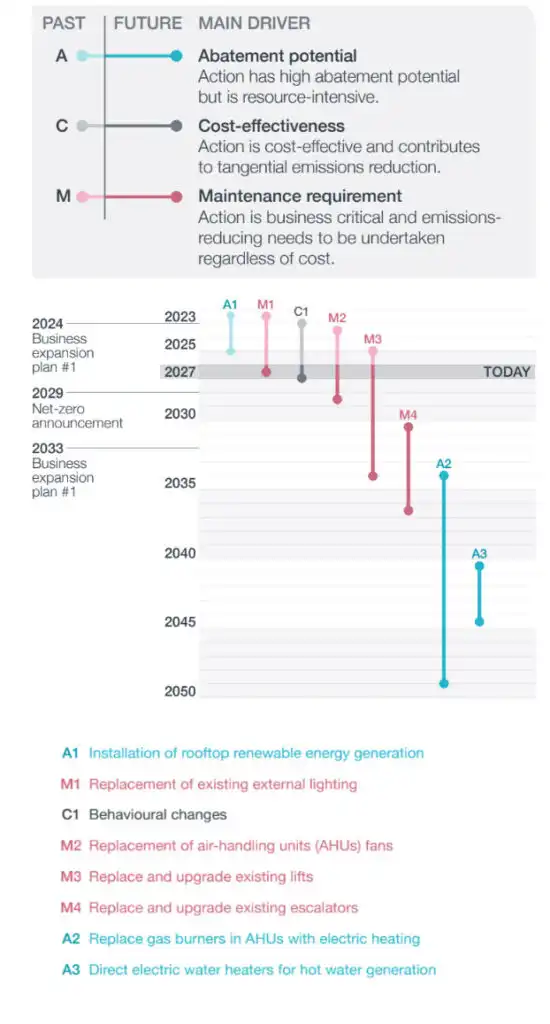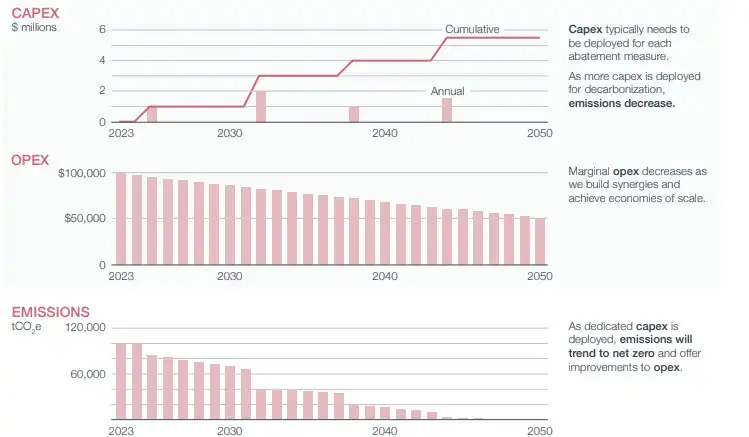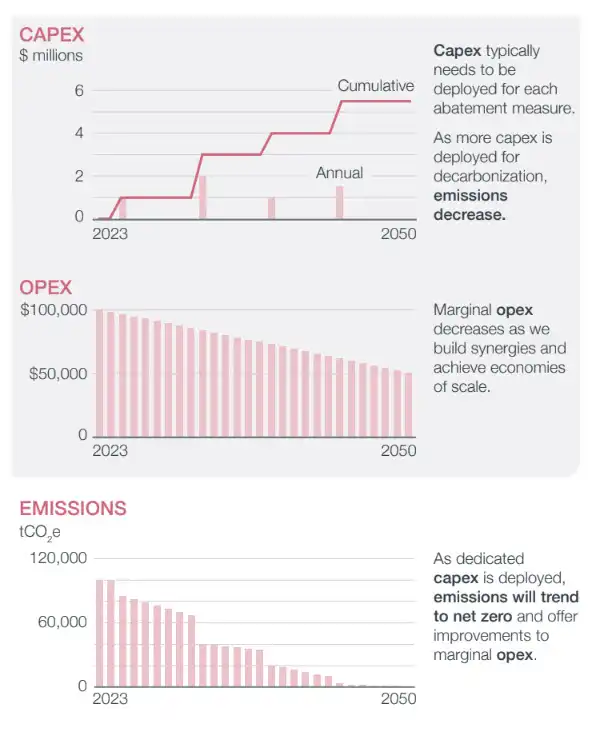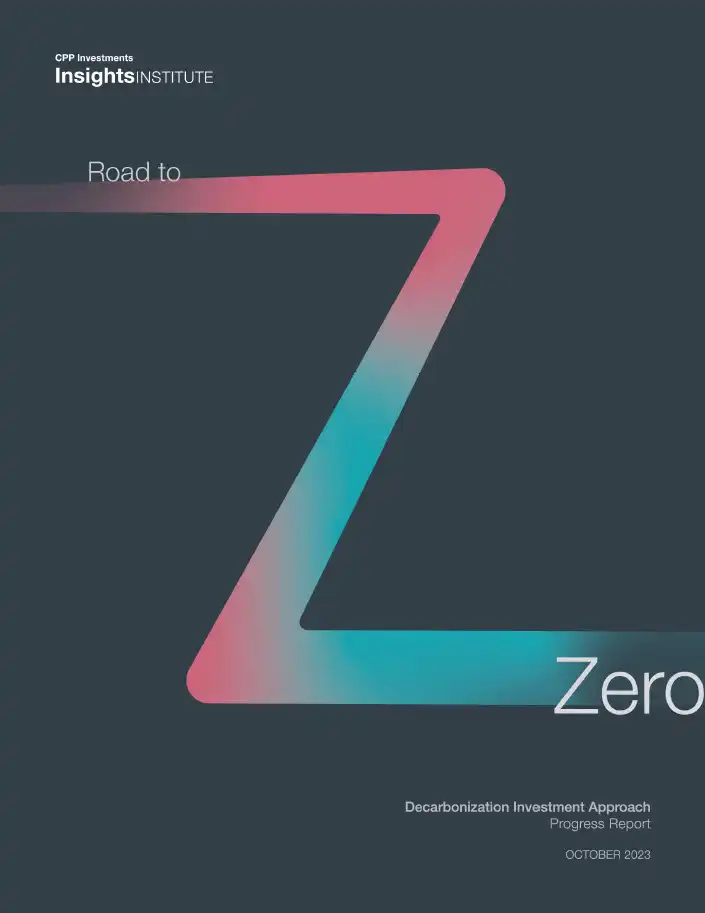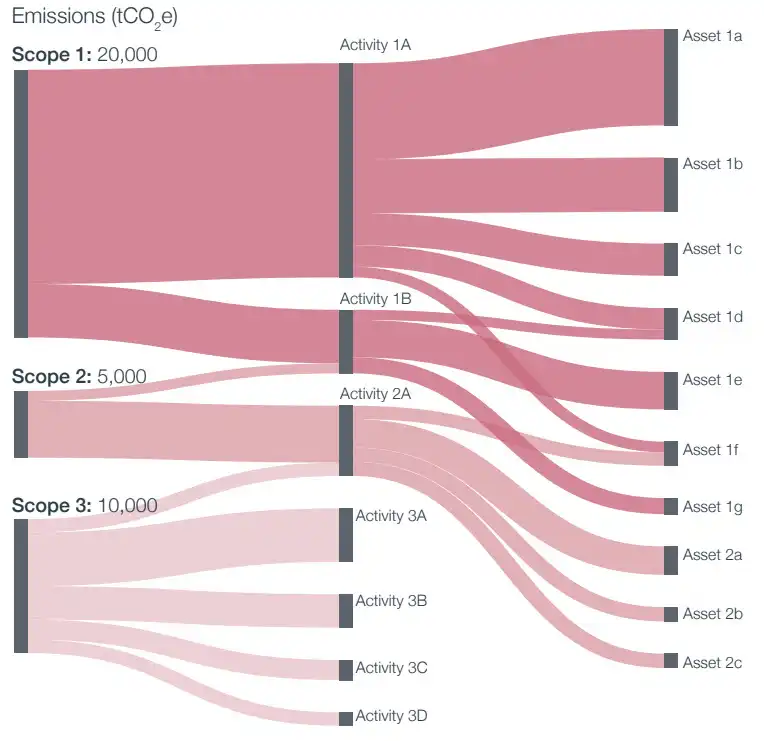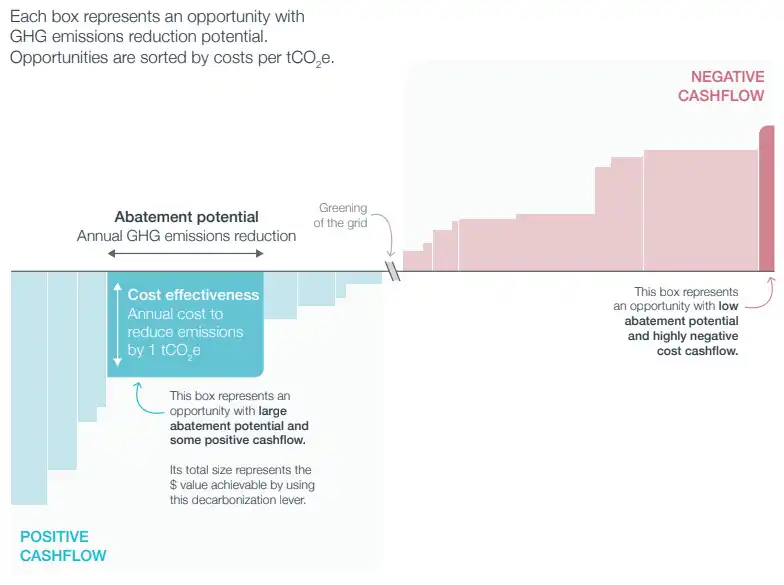The time to take action is now
The time to take action is now
At CPP Investments, we have committed to attaining net-zero greenhouse gas (GHG) emissions across all scopes1 in our operations and portfolio by 2050. We seek to do this while fulfilling our mandate of maximizing returns without undue risk of loss, taking into account the factors that may affect the funding of the Canada Pension Plan and its ability to meet its financial obligations. The governments of most of the markets in which we invest have committed to comprehensive decarbonization of their economies by 2050. Given this, companies must identify and integrate decarbonization insights into their business plans to ensure strategic alignment with this policy outlook to protect and grow value over the coming decades.
To be clear, our net-zero commitment is made on the basis and with the expectation that the global community will continue to advance towards the goal of achieving net-zero greenhouse gas emissions by 2050. These advancements include the acceleration and fulfilment of commitments made by governments, technological progress, fulfilment of corporate targets, changes in consumer and corporate behaviours, and development of global reporting standards and carbon markets, all of which will be necessary for us to meet our commitment.2
A key component of our net-zero commitment is our Decarbonization Investment Approach (DIA), which we introduced in December 2021 to identify, fund and support the decarbonization efforts of high-emitting companies and capture the value of the whole economy transition.
We are now testing the DIA within our portfolio starting with an initial cohort of over ten portfolio companies.3 The collective scope 1 and 2 emissions of the companies selected for this trial, as of March 31, 2023, exceeded 3.5 million tonnes of C02e — approximately 16.4% of the total emissions of our non-government holdings. Through this trial, we have been able to partner with portfolio companies to help them reduce emissions from their operations, deepen our understanding of sector-specific decarbonization levers and enable us to create decarbonization playbooks for a broad range of sectors while creating long-term value. This is an ongoing process, and we continue to glean insights from this effort – this paper describes the DIA and our experience thus far.
Portfolio company selection considerations
Five key considerations guided the identification process for the first cohort of portfolio companies for our Decarbonization Investment Approach (DIA):
- The company has large absolute emissions and/or high emissions intensity that provide a meaningful opportunity to create impact through decarbonization measures.
- The company operates in a strategic sector, where learnings could be applied and scaled.
- CPP Investments holds a meaningful ownership position. This would be critical to our ability to influence and affect change.
- The company has potential to increase its value and become a more lucrative long-term investment as a result of a more sustainable business model.
- There is interest and willingness from the company’s senior management and/or the board to participate in the multi-month program. In addition, they commit to incorporating the findings from the process into their long-term planning.
Interested in learning more about the DIA? Contact Peter Busse pbusse@cppib.com or Michael Hall mhall@cppib.com.
The Decarbonization Investment Approach in three steps
Our goal is to decarbonize our portfolio at scale. The DIA offers a rigorous and structured process to yield comparable results that can be refined by sector. The process includes three steps:
1Establish emissions baseline and trajectory
The first step in the DIA is to calculate an emissions baseline for the company by identifying and measuring all emissions across the organization (Scope 1 and 2) and, where material, indirect emissions from a company’s supply chain (Scope 3). This assessment is conducted both based on a company’s emissions profile today, and a business-as-usual (BAU) projection based on current business plans.4
A decarbonization plan cannot be developed inside the executive office alone. Calculating baseline emissions for a company requires engagement from employees across the enterprise, including, experts from facilities management, HVAC engineers through to procurement, finance and sustainability teams. So, this step involves aligning with internal stakeholders; carrying out site visits to identify actual emissions sources; conducting analysis to validate existing operations and sources of GHG emissions; and assessing and updating existing data to ensure comparability.
Figure 1: Illustrative example of emissions baselining
Figure 1: Illustrative example of emissions baselining
2Assess current and projected abatement capacity
Once the team calculates current emissions, the next step is to conduct an abatement capacity assessment (ACA), to quantify and categorize the cost of reducing emissions from each source. CPP Investments’ Abatement Capacity Assessment Framework, which we launched in 2021, is an innovative, open-source tool that provides a step-by-step guide to explore the technical and economic feasibility and emissions-reduction potential of individual decarbonization options. Utilizing the framework, the team can calculate the marginal abatement cost of different abatement measures, which are best represented by a marginal abatement cost curve (MACC). While developing marginal abatement cost curves (MACC) has been a common tool in the industry for several years, we found that specific refinements enhanced the accuracy and utility of the output:
- Counterfactual assessment: It is important that marginal costs are calculated on a ‘counterfactual’ basis, by quantifying the incremental cost of the abatement measure compared to their BAU replacement cycles. This calculation is completed by assuming a ‘like-for-like’ replacement of the selected equipment given the cost profile – both capital expenditure (capex) and operational expenditure (opex) of the selected abatement measure. While this requires more work and greater understanding of the installed plant, skipping this process risks overestimating the costs of decarbonization and as a result stunting ambition to reduce emissions, which in turn, could impair the value of a business.
- Prioritization of efficiency: When conducting the abatement capacity assessment, companies need to take a sequential approach to identifying emissions-reduction opportunities. This should start by identifying all “efficiency” measures that reduce emissions without requiring capital outlay. Thereafter, they should identify decarbonization levers that reduce demand (e.g., energy demand) and investments in greening supply (e.g., procurement of green energy), while taking into consideration the decarbonization of the grid. Efficiency measures are often overlooked because of the perception that they are unlikely to be material and can be difficult to calculate. Yet, every 7% of emissions reduction through efficiency measures can get us a year closer to Paris Alignment without increasing either capex or opex. Efficiency measures are not only the most accretive source of emissions reduction, but also enable companies to buy time as other more technical and capex-intensive decarbonization levers evolve. By taking this sequential approach, companies can maximize emissions abatement at the lowest cost.
The assessment then moves into calculating the projected abatement capacity (PAC) of a company, providing a clear view of proven, probable and uneconomic emissions-reduction opportunities based on their associated costs. The proven category represents the emissions each company could abate economically today using available and proven technologies. The probable category includes emissions the company can abate over time, based on a more conservative, “probable” scenario, in which regulations and technology costs hold steady, while the cost of carbon rises. The result is a “safe to assume” picture of where and when the company can cut emissions over a 10-25 year period. Lastly, the “uneconomic” abatement capacity represents those emissions that are either technically not possible to abate or require a high carbon price, e.g., one in excess of $150/tCO2e.
Figure 2: Illustrative example of select decarbonization levers from companies across different sectors
Within this step, many companies in our trial found it beneficial to conduct scenario analysis on their decarbonization pathways. Given the uncertainty of both the development of key technologies (e.g., carbon capture, utilization and storage (CCUS)) and market dynamics (e.g., supply of green H2), it is especially important to understand the associated trade-offs, projected abatement capacity and resulting financial implications of various scenarios.
Figure 2: Illustrative example of select decarbonization levers from companies across different sectors
Within this step, many companies in our trial found it beneficial to conduct scenario analysis on their decarbonization pathways. Given the uncertainty of both the development of key technologies (e.g., carbon capture, utilization and storage (CCUS)) and market dynamics (e.g., supply of green H2), it is especially important to understand the associated trade-offs, projected abatement capacity and resulting financial implications of various scenarios.
Figure 3: Illustrative example of a company’s marginal abatement cost curve
Figure 3: Illustrative example of a company’s marginal abatement cost curve
3Define decarbonization ambition and action plan
Drawing on the data and analyses from steps 1 and 2 above, a company is now able to build a robust action plan to both present the transition pathway to key stakeholders, and effectively integrate it into its business plan.
The company should have detailed discussions around a feasible and ambitious pathway and prioritize economic (proven) abatement actions that will have the highest impact, per dollar spent. The company should then have internal discussions around long-term (probable) measures that require higher net capital expenditures, based on its climate ambition. This may include an internal carbon price, reputational considerations, customer expectations, key sustainability objectives and engagement with regulators. The framework can help prompt strategic discussions regarding emissions associated with emissions that are either technically not possible to abate or currently very uneconomic. Strategic decision(s) need to be taken around (i) closure/shutdown of operations, (ii) reliance on technological innovation/moonshot solutions, and/or (iii) purchase of high-quality carbon offsets.
There are a few key outputs, that can help showcase the company’s chosen decarbonization plan:
- Emissions abatement waterfall: showcasing the emissions reduction plan, from current and projected baseline through to the end-state target year.
Figure 4: Illustrative example of a company’s emissions abatement waterfall
There are a few key outputs, that can help showcase the company’s chosen decarbonization plan:
- Emissions abatement waterfall: showcasing the emissions reduction plan, from current and projected baseline through to the end-state target year.
Figure 4: Illustrative example of a company’s emissions abatement waterfall
- Implementation timeline: outlining the key measures and their respective implementation dates with an overlay of any key corporate decisions/announcements that need to be made (e.g., announcing net-zero commitment).
Figure 5: Illustrative example of implementation timeline for a real estate asset
- Capex/opex schedule: visualization of when investments are required, and when to expect any associated opex benefits during the decarbonization pathway.
- Implementation timeline: outlining the key measures and their respective implementation dates with an overlay of any key corporate decisions/announcements that need to be made (e.g., announcing net-zero commitment).
Figure 5: Illustrative example of implementation timeline for a real estate asset
- Capex/opex schedule: visualization of when investments are required, and when to expect any associated opex benefits during the decarbonization pathway.
Figure 6: Illustrative example of capex/opex schedules and emissions trajectory for a company based on its decarbonization plan
Together these outputs help management establish robust decarbonization roadmaps that are closely integrated into business plans for the highest probability to materialize emissions reductions.
Figure 6: Illustrative example of capex/opex schedules and emissions trajectory for a company based on its decarbonization plan
Together these outputs help management establish robust decarbonization roadmaps that are closely integrated into business plans for the highest probability to materialize emissions reductions.
Opportunities and barriers for decarbonization
While all of the companies in our initial cohort uncovered interventions that could quickly reduce emissions, their decarbonization opportunities differ considerably in terms of feasibility and cost, based on their individual circumstances. At a macro-level, however, clear insights emerged about the decarbonization opportunities and barriers companies face.
- Efficiency affords an opportunity to engage the whole employee base in decarbonization: While unlikely to be a large share of the total projected abatement capacity, efficiency should be prioritized for three reasons, (i) it is always the most economic, (ii) it creates breathing space to develop the final transition plan and (iii) requires employee engagement allowing employers to position decarbonization as a retention tool.
- Companies can take scope 2 emissions reductions in their own hands: Off-site/virtual procurement of renewable energy is a common decarbonization theme, with strong expected growth for on-site rooftop solar, where feasible. As many nations and regions undertake efforts to decarbonize their grids, the use of off-site offtake agreements, such as power purchase agreements (PPAs), serve as a strong near-term solution for emissions reductions.
- Bridge solutions should be explored to “buy” time as technology evolves: In instances where either technology maturity and/or costs profiles of low-carbon solutions are unfavorable but quickly evolving, interim/bridge solutions can be taken that have limited impact to capital expenditure. Examples such as drop-in biofuels, purchase of bio-gas and in some cases, extension of the useful life of an equipment can provide a sufficient time buffer until new low-carbon equipment are more commercially available.
- Uncertainty of certain solutions lies beyond technical maturity: While many companies highlight the technical challenges of certain decarbonization solutions (e.g. CCUS, Green H2), there are also several supply-chain dynamics that place additional uncertainty on their adoption. For example, while the technology for CCUS is still evolving, there is uncertainty around storage and usage of captured carbon and associated permitting that is required for the technology to be deployed at scale.
Lessons for investors
We’re still at the start of our portfolio’s decarbonization journey, but have learned important lessons that may be valuable to other investors that aspire to reduce emissions across their portfolios.
- There is no one-size-fits-all plan: While companies in similar sectors and geographies may share similar emissions drivers, there is no such thing as a “one-size-fits-all” decarbonization action plan. In many cases it may be necessary to engage advisors with expertise in the particular geographies, regulatory contexts and sectors of the companies being assessed in order to develop feasible decarbonization plans.
- A full-company approach is required: A decarbonization assessment is not a sustainability initiative in isolation, but rather a full-company transformation. It requires both top-down engagement, from the board and C-suite, as well as involvement across multiple departments such as finance, procurement, operations and facilities. To build a robust decarbonization roadmap is not an easy task, and requires adequate resourcing, budgeting, and planning. However, when done well, we have found it strengthens management conviction in their decarbonization ambition, and creates value and reduces risk.
- The plan needs to be actionable: We are working with our initial cohort to set short-term decarbonization targets, make sure decarbonization plans are integrated into the company’s business plans and formulate metrics to ensure actions are taken and results measured.
Integrating sustainability considerations into all phases of the investment life cycle is fundamental to CPP Investments’ commitment to reducing emissions in our portfolio and creating long-term value for contributors and beneficiaries. Based on our efforts to date, we believe that our decarbonization investment approach can strengthen and accelerate our ability to meet that commitment.

Richard Manley
Chief Sustainability Officer

Cesare Ruggiero
Managing Director, Head of Portfolio Value Creation, Real Assets

Peter Busse
Managing Director, Portfolio Value Creation, Real Assets

Michael Hall
Managing Director, Portfolio Value Creation, Real Assets

Som Ghosh
Senior Associate, Portfolio Value Creation, Real Assets

John Guo
Senior Associate, Portfolio Value Creation, Real Assets
1 Scope 1 refers to direct GHG emissions from an organization’s owned and controlled sources. Scope 2 refers to indirect emissions from the generation of purchased energy. Scope 3 refers to all indirect emissions (not included in Scope 2) that occur in the value chain of the reporting company, including both upstream and downstream emissions.
2 For more details on our net-zero commitment, see https://www.cppinvestments.com/sustainable-investing/.
3 See CPP Investments Insights Institute’s The Decarbonization Imperative paper for a detailed case study of the Trafford Centre decarbonization project: https://www.cppinvestments.com/insights-institute/the-decarbonization-imperative/.
4 Given the inherent challenges with determining Scope 3 emissions, we only include these in our baseline calculations where material.
Disclaimer:
The Reports on this page are for historical reference only and are current as of their respective dates. They may be superseded by more recent information. We do not update past Reports or any historical information, whether because of new information, future events, or otherwise, unless required by law.
Johan Rockström is one of the world’s most prominent climate scientists.
Video
•
March 3, 2025
The energy transition is a defining test of our time—one that no single government, investor, or company can meet alone.
Article
•
December 17, 2024
In February 2022, CPP Investments committed to reaching net zero greenhouse gas emissions across its portfolio and operations by 2050.
Article
•
May 16, 2024
The time to take action is now The time to take action is now At CPP Investments, we have committed to attaining net-zero greenhouse gas (GHG) emissions across all scopes1 in our operations and portfolio by 2050. We seek to do this while fulfilling our mandate of maximizing returns without undue risk of loss, taking into account the factors that may affect the funding of the Canada Pension Plan and its ability to meet its financial obligations. The governments of most of the markets in which we invest have committed to comprehensive decarbonization of their economies by 2050. Given this, companies must identify and integrate decarbonization insights into their business plans to ensure strategic alignment with this policy outlook to protect and grow value over the coming decades. To be clear, our net-zero commitment is made on the basis and with the expectation that the global community will continue to advance towards the goal of achieving net-zero greenhouse gas emissions by 2050. These advancements include the acceleration and fulfilment of commitments made by governments, technological progress, fulfilment of corporate targets, changes in consumer and corporate behaviours, and development of global reporting standards and carbon markets, all of which will be necessary for us to meet our commitment.2 Download Report Table of Contents The Decarbonization Investment Approach in three steps Step 1: Establish emissions baseline and trajectoryStep 2: Assess current and projected abatement capacityStep 3: Define decarbonization ambition and action plan Opportunities and barriers for decarbonization Lessons for investors A key component of our net-zero commitment is our Decarbonization Investment Approach (DIA), which we introduced in December 2021 to identify, fund and support the decarbonization efforts of high-emitting companies and capture the value of the whole economy transition. We are now testing the DIA within our portfolio starting with an initial cohort of over ten portfolio companies.3 The collective scope 1 and 2 emissions of the companies selected for this trial, as of March 31, 2023, exceeded 3.5 million tonnes of C02e -- approximately 16.4% of the total emissions of our non-government holdings. Through this trial, we have been able to partner with portfolio companies to help them reduce emissions from their operations, deepen our understanding of sector-specific decarbonization levers and enable us to create decarbonization playbooks for a broad range of sectors while creating long-term value. This is an ongoing process, and we continue to glean insights from this effort - this paper describes the DIA and our experience thus far. Portfolio company selection considerations Five key considerations guided the identification process for the first cohort of portfolio companies for our Decarbonization Investment Approach (DIA): The company has large absolute emissions and/or high emissions intensity that provide a meaningful opportunity to create impact through decarbonization measures. The company operates in a strategic sector, where learnings could be applied and scaled. CPP Investments holds a meaningful ownership position. This would be critical to our ability to influence and affect change. The company has potential to increase its value and become a more lucrative long-term investment as a result of a more sustainable business model. There is interest and willingness from the company’s senior management and/or the board to participate in the multi-month program. In addition, they commit to incorporating the findings from the process into their long-term planning. Interested in learning more about the DIA? Contact Peter Busse pbusse@cppib.com or Michael Hall mhall@cppib.com. The Decarbonization Investment Approach in three steps Our goal is to decarbonize our portfolio at scale. The DIA offers a rigorous and structured process to yield comparable results that can be refined by sector. The process includes three steps: 1Establish emissions baseline and trajectory The first step in the DIA is to calculate an emissions baseline for the company by identifying and measuring all emissions across the organization (Scope 1 and 2) and, where material, indirect emissions from a company’s supply chain (Scope 3). This assessment is conducted both based on a company’s emissions profile today, and a business-as-usual (BAU) projection based on current business plans.4 A decarbonization plan cannot be developed inside the executive office alone. Calculating baseline emissions for a company requires engagement from employees across the enterprise, including, experts from facilities management, HVAC engineers through to procurement, finance and sustainability teams. So, this step involves aligning with internal stakeholders; carrying out site visits to identify actual emissions sources; conducting analysis to validate existing operations and sources of GHG emissions; and assessing and updating existing data to ensure comparability. Figure 1: Illustrative example of emissions baselining Figure 1: Illustrative example of emissions baselining 2Assess current and projected abatement capacity Once the team calculates current emissions, the next step is to conduct an abatement capacity assessment (ACA), to quantify and categorize the cost of reducing emissions from each source. CPP Investments’ Abatement Capacity Assessment Framework, which we launched in 2021, is an innovative, open-source tool that provides a step-by-step guide to explore the technical and economic feasibility and emissions-reduction potential of individual decarbonization options. Utilizing the framework, the team can calculate the marginal abatement cost of different abatement measures, which are best represented by a marginal abatement cost curve (MACC). While developing marginal abatement cost curves (MACC) has been a common tool in the industry for several years, we found that specific refinements enhanced the accuracy and utility of the output: Counterfactual assessment: It is important that marginal costs are calculated on a ‘counterfactual’ basis, by quantifying the incremental cost of the abatement measure compared to their BAU replacement cycles. This calculation is completed by assuming a ‘like-for-like’ replacement of the selected equipment given the cost profile – both capital expenditure (capex) and operational expenditure (opex) of the selected abatement measure. While this requires more work and greater understanding of the installed plant, skipping this process risks overestimating the costs of decarbonization and as a result stunting ambition to reduce emissions, which in turn, could impair the value of a business. Prioritization of efficiency: When conducting the abatement capacity assessment, companies need to take a sequential approach to identifying emissions-reduction opportunities. This should start by identifying all “efficiency” measures that reduce emissions without requiring capital outlay. Thereafter, they should identify decarbonization levers that reduce demand (e.g., energy demand) and investments in greening supply (e.g., procurement of green energy), while taking into consideration the decarbonization of the grid. Efficiency measures are often overlooked because of the perception that they are unlikely to be material and can be difficult to calculate. Yet, every 7% of emissions reduction through efficiency measures can get us a year closer to Paris Alignment without increasing either capex or opex. Efficiency measures are not only the most accretive source of emissions reduction, but also enable companies to buy time as other more technical and capex-intensive decarbonization levers evolve. By taking this sequential approach, companies can maximize emissions abatement at the lowest cost. The assessment then moves into calculating the projected abatement capacity (PAC) of a company, providing a clear view of proven, probable and uneconomic emissions-reduction opportunities based on their associated costs. The proven category represents the emissions each company could abate economically today using available and proven technologies. The probable category includes emissions the company can abate over time, based on a more conservative, “probable” scenario, in which regulations and technology costs hold steady, while the cost of carbon rises. The result is a “safe to assume” picture of where and when the company can cut emissions over a 10-25 year period. Lastly, the “uneconomic” abatement capacity represents those emissions that are either technically not possible to abate or require a high carbon price, e.g., one in excess of $150/tCO2e. Figure 2: Illustrative example of select decarbonization levers from companies across different sectors Within this step, many companies in our trial found it beneficial to conduct scenario analysis on their decarbonization pathways. Given the uncertainty of both the development of key technologies (e.g., carbon capture, utilization and storage (CCUS)) and market dynamics (e.g., supply of green H2), it is especially important to understand the associated trade-offs, projected abatement capacity and resulting financial implications of various scenarios. Figure 2: Illustrative example of select decarbonization levers from companies across different sectors Within this step, many companies in our trial found it beneficial to conduct scenario analysis on their decarbonization pathways. Given the uncertainty of both the development of key technologies (e.g., carbon capture, utilization and storage (CCUS)) and market dynamics (e.g., supply of green H2), it is especially important to understand the associated trade-offs, projected abatement capacity and resulting financial implications of various scenarios. Figure 3: Illustrative example of a company's marginal abatement cost curve Figure 3: Illustrative example of a company's marginal abatement cost curve 3Define decarbonization ambition and action plan Drawing on the data and analyses from steps 1 and 2 above, a company is now able to build a robust action plan to both present the transition pathway to key stakeholders, and effectively integrate it into its business plan. The company should have detailed discussions around a feasible and ambitious pathway and prioritize economic (proven) abatement actions that will have the highest impact, per dollar spent. The company should then have internal discussions around long-term (probable) measures that require higher net capital expenditures, based on its climate ambition. This may include an internal carbon price, reputational considerations, customer expectations, key sustainability objectives and engagement with regulators. The framework can help prompt strategic discussions regarding emissions associated with emissions that are either technically not possible to abate or currently very uneconomic. Strategic decision(s) need to be taken around (i) closure/shutdown of operations, (ii) reliance on technological innovation/moonshot solutions, and/or (iii) purchase of high-quality carbon offsets. There are a few key outputs, that can help showcase the company’s chosen decarbonization plan: Emissions abatement waterfall: showcasing the emissions reduction plan, from current and projected baseline through to the end-state target year. Figure 4: Illustrative example of a company's emissions abatement waterfall There are a few key outputs, that can help showcase the company’s chosen decarbonization plan: Emissions abatement waterfall: showcasing the emissions reduction plan, from current and projected baseline through to the end-state target year. Figure 4: Illustrative example of a company's emissions abatement waterfall Implementation timeline: outlining the key measures and their respective implementation dates with an overlay of any key corporate decisions/announcements that need to be made (e.g., announcing net-zero commitment). Figure 5: Illustrative example of implementation timeline for a real estate asset Capex/opex schedule: visualization of when investments are required, and when to expect any associated opex benefits during the decarbonization pathway. Implementation timeline: outlining the key measures and their respective implementation dates with an overlay of any key corporate decisions/announcements that need to be made (e.g., announcing net-zero commitment). Figure 5: Illustrative example of implementation timeline for a real estate asset Capex/opex schedule: visualization of when investments are required, and when to expect any associated opex benefits during the decarbonization pathway. Figure 6: Illustrative example of capex/opex schedules and emissions trajectory for a company based on its decarbonization plan Together these outputs help management establish robust decarbonization roadmaps that are closely integrated into business plans for the highest probability to materialize emissions reductions. Figure 6: Illustrative example of capex/opex schedules and emissions trajectory for a company based on its decarbonization plan Together these outputs help management establish robust decarbonization roadmaps that are closely integrated into business plans for the highest probability to materialize emissions reductions. Opportunities and barriers for decarbonization While all of the companies in our initial cohort uncovered interventions that could quickly reduce emissions, their decarbonization opportunities differ considerably in terms of feasibility and cost, based on their individual circumstances. At a macro-level, however, clear insights emerged about the decarbonization opportunities and barriers companies face. Efficiency affords an opportunity to engage the whole employee base in decarbonization: While unlikely to be a large share of the total projected abatement capacity, efficiency should be prioritized for three reasons, (i) it is always the most economic, (ii) it creates breathing space to develop the final transition plan and (iii) requires employee engagement allowing employers to position decarbonization as a retention tool. Companies can take scope 2 emissions reductions in their own hands: Off-site/virtual procurement of renewable energy is a common decarbonization theme, with strong expected growth for on-site rooftop solar, where feasible. As many nations and regions undertake efforts to decarbonize their grids, the use of off-site offtake agreements, such as power purchase agreements (PPAs), serve as a strong near-term solution for emissions reductions. Bridge solutions should be explored to “buy” time as technology evolves: In instances where either technology maturity and/or costs profiles of low-carbon solutions are unfavorable but quickly evolving, interim/bridge solutions can be taken that have limited impact to capital expenditure. Examples such as drop-in biofuels, purchase of bio-gas and in some cases, extension of the useful life of an equipment can provide a sufficient time buffer until new low-carbon equipment are more commercially available. Uncertainty of certain solutions lies beyond technical maturity: While many companies highlight the technical challenges of certain decarbonization solutions (e.g. CCUS, Green H2), there are also several supply-chain dynamics that place additional uncertainty on their adoption. For example, while the technology for CCUS is still evolving, there is uncertainty around storage and usage of captured carbon and associated permitting that is required for the technology to be deployed at scale. Lessons for investors We’re still at the start of our portfolio’s decarbonization journey, but have learned important lessons that may be valuable to other investors that aspire to reduce emissions across their portfolios. There is no one-size-fits-all plan: While companies in similar sectors and geographies may share similar emissions drivers, there is no such thing as a “one-size-fits-all” decarbonization action plan. In many cases it may be necessary to engage advisors with expertise in the particular geographies, regulatory contexts and sectors of the companies being assessed in order to develop feasible decarbonization plans. A full-company approach is required: A decarbonization assessment is not a sustainability initiative in isolation, but rather a full-company transformation. It requires both top-down engagement, from the board and C-suite, as well as involvement across multiple departments such as finance, procurement, operations and facilities. To build a robust decarbonization roadmap is not an easy task, and requires adequate resourcing, budgeting, and planning. However, when done well, we have found it strengthens management conviction in their decarbonization ambition, and creates value and reduces risk. The plan needs to be actionable: We are working with our initial cohort to set short-term decarbonization targets, make sure decarbonization plans are integrated into the company’s business plans and formulate metrics to ensure actions are taken and results measured. Integrating sustainability considerations into all phases of the investment life cycle is fundamental to CPP Investments’ commitment to reducing emissions in our portfolio and creating long-term value for contributors and beneficiaries. Based on our efforts to date, we believe that our decarbonization investment approach can strengthen and accelerate our ability to meet that commitment. Executive Sponsors Richard Manley Chief Sustainability Officer Cesare Ruggiero Managing Director, Head of Portfolio Value Creation, Real Assets Contributors Peter Busse Managing Director, Portfolio Value Creation, Real Assets Michael Hall Managing Director, Portfolio Value Creation, Real Assets Som Ghosh Senior Associate, Portfolio Value Creation, Real Assets John Guo Senior Associate, Portfolio Value Creation, Real Assets Visualizations by Voilà. 1 Scope 1 refers to direct GHG emissions from an organization’s owned and controlled sources. Scope 2 refers to indirect emissions from the generation of purchased energy. Scope 3 refers to all indirect emissions (not included in Scope 2) that occur in the value chain of the reporting company, including both upstream and downstream emissions. 2 For more details on our net-zero commitment, see https://www.cppinvestments.com/sustainable-investing/. 3 See CPP Investments Insights Institute’s The Decarbonization Imperative paper for a detailed case study of the Trafford Centre decarbonization project: https://www.cppinvestments.com/insights-institute/the-decarbonization-imperative/. 4 Given the inherent challenges with determining Scope 3 emissions, we only include these in our baseline calculations where material. Disclaimer: The Reports on this page are for historical reference only and are current as of their respective dates. They may be superseded by more recent information. We do not update past Reports or any historical information, whether because of new information, future events, or otherwise, unless required by law. Climate Change Physical Risk, Climate Change, and the Investor Response Johan Rockström is one of the world’s most prominent climate scientists. Video • March 3, 2025 Climate Change Why collaboration is key to achieving the energy transition and meeting global The energy transition is a defining test of our time—one that no single government, investor, or company can meet alone. Article • December 17, 2024 Climate Change Road to Zero: Harvard Business School highlights CPP Investments’ Net Zero In February 2022, CPP Investments committed to reaching net zero greenhouse gas emissions across its portfolio and operations by 2050. Article • May 16, 2024
